
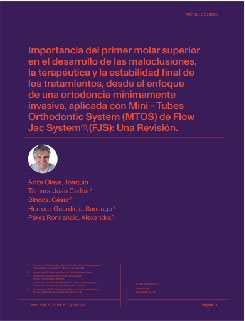
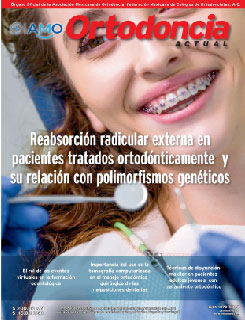

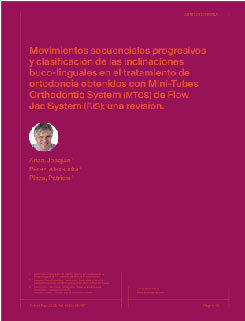
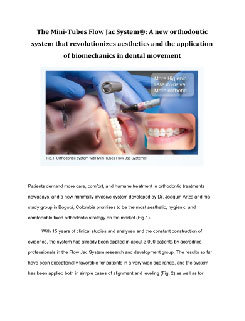
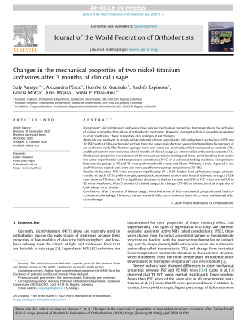
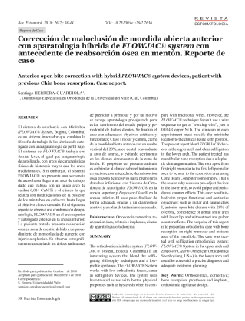



Importance of the upper first molar in the development of malocclusions, therapy and final treatment stability from a minimally invasive orthodontic approach, applied with the Flow Jac System® Mini-Tubes Orthodontic System (MTOS) (FJS): A Review.
Objective:
Describe the importance of the position, angulation and morphology of the upper first molar in the construction of the diagnosis, treatment objective, therapeutics and the achievement of post orthodontic treatment stability, described in the treatment philosophy of the Flow Jac System® (FJS) Mini-Tubes Orthodontic System (MTOS); and additionally provide a practical explanation of how the system guides the positioning of the mini-tubes in the cementation of the upper first molars to achieve an adequate adjustment and management of the posterior occlusal plane looking for a new postural adaptation of the stomatognathic system.
Conclusions:
The application of the Flow Jac System® (FJS) Mini-Tubes Orthodontic System (MTOS) orthodontic philosophy and treatment protocols in the correction of malocclusions through proper positioning, management of the upper first molar and occlusal plane, promotes greater post-treatment adjustment and stability, respecting from the placement of the appliance, the natural and adaptive characteristics of the upper first molar, constituting at the same time a guide to be taken into account in the positioning of the brackets in any orthodontic technique and with the objective of maintaining stability in the new position.
Materials and methods:
A review was performed in search engines where 45 initial articles were found; 6 articles that met the inclusion criteria were read and accepted, in order to perform a critical analysis of the literature.
Tripoidal guides and neural stimulus classification in class II division 2 orthodontic treatment with Flow Jac System®(FJS) Mini-tubesOrthodontic System (MTOS): a review.
Objective:
To describe the basic fundamentals and therapeutic principles of tripoidal neural occlusal guides (GONT), as well as their application and clinical procedures in the correction of class II division 2 malocclusions with mandibular repositioning, through the treatment philosophy with Flow Jac System® (FJS) Mini-tubes Orthodontic System (MTOS), and additionally provide a practical classification of the neural stimuli according to the element that transfers them and the anatomical structure that receives and conducts them, in order to achieve a dynamic mandibular repositioning with a new postural adaptation of the stomatognathic system.
Conclusions:
The application of the Flow Jac System® (FJS) Mini-tubes Orthodontic System (MTOS) treatment philosophy and protocols, in the correction of class II division 2 malocclusions with mandibular repositioning, through the tripoidal neural occlusal guides (GONT), promotes greater stability during therapeutic development by guiding the mandible through direct neural occlusal contacts that stimulate repositioning, while constituting a retrusive stop and maintaining stability in the new position.
Materials and methods:
An electronic engine search was conducted and 46 articles with appropriate inclusion criteria were found. A literature review was performed.
Key words:
Class II division 2 malocclusions, Mandibular repositioning, Mini-tubes Orthodontic System.
Assessment of three-dimensional changes after orthodontic treatment of low-complexity cases, using self-ligating brackets, conventional brackets or bracketless fixed system
Objective:
The aim of this study was to compare crown angulation, inclination, and arch dimension changes after orthodontic treatment across three bracket systems: self-ligating, conventional, and bracketless fixed systems.
Methods:
Pre and posttreatment digital models from 114 patients aged 16 to 44 years, classified as low complexity cases, who had similar skeletal and dental pretreatment parameters and underwent orthodontic treatment, were divided into three groups: Group 1 (n = 40), treated with conventional brackets; Group 2 (n = 40), treated with self-ligating brackets; Group 3 (n = 34), treated with a bracketless fixed system. Upper and lower final crown angulation (tipping), inclination (torque), and arch dimension were measured using Dolphin software (Dolphin Imaging and Management Solutions, Chatsworth, CA, USA) by a calibrated operator. The statistical analysis was carried out with the chi-square test, an ANOVA/Kruskal-Wallis test, the paired-sample t test/Wilcoxon matched-pairs signed-rank test, and a multinomial regression model.
Results:
No statistically significant differences across the groups were found after orthodontic treatment. However, in the comparison of pre- and posttreatment intragroup changes, statistically significant differences (p < 0.0014) were found in some of the studied variables. The multinomial regression model showed a statistically significant association (p < 0.05) between self-ligating brakets and the maxillary interpremolar (first) width (OR = 1.58, 95% CI = 1.09–2.30) and the mandibular arch perimeter (OR = 0.77, 95% CI = 0.61–0.98) after orthodontic treatment, compared with conventional brackets.
Conclusions:
Pre- and posttreatment crown angulation, inclination, and arch dimension values across the three orthodontic appliance types showed no statistically significant differences in this sample of orthodontic low complexity cases.
Keywords:
Orthodontic appliances. Orthodontic brackets. Torque. Dental arch. Dental models.
Progressive sequential movements and classification of bucco-lingual inclinations in orthodontic treatment obtained with Flow Jac System (FJS) Mini-Tubes Orthodontic System (MTOS): a review.
Objective:
To describe the treatment philosophy of the Flow Jac System (FJS) Mini-Tubes Orthodontic System (MTOS), the treatment protocols and to classify the bucco-lingual (B-L) movements obtained with the application of various biomechanics. This is a minimally invasive system where the bracket is replaced by a mini-tube with an internal diameter of less than 1mm, which serves as a support point for an archwire to produce dental movements and solve multiple malocclusions with elaborated protocols, where it is relevant to classify the B-L movements, obtained with the application of force vectors, in order to respect the adaptive positions of the root inside the alveolus.
Conclusions:
The application of the FJS MTOS treatment philosophy and protocols promotes sequential movements with light forces, decreasing tissue damage and undesirable movements allowing optimization of treatment time by synchronizing primary, secondary and tertiary B-L tilt movements from the beginning of treatment.
Key words:
Tooth movement techniques, Corrective orthodontics, Orthodontic wires, Torque, Mini-Tubes.
The Mini-Tubes Flow Jac System®: A new orthodontic system that revolutionizes aesthetics and the application of biomechanics in dental movement.
Objective:
Dr. Joaquín Ariza, creator along with his study group in Bogotá of a minimally invasive orthodontic system based on minitubes, states that this is an esthetic, hygienic and comfortable fixed orthodontic strategy.
Changes in the mechanical properties of two nickel-titanium archwires after 3 months of clinical usage
Background:
Nickel-titanium archwires have unique mechanical properties that make them the archwire of choice during the first phase of orthodontic treatment. However, during its clinical use when subjected to oral conditions, these properties can undergo great changes.
Materials and methods:
A sample of 24 randomly chosen superelastic NiTi orthodontic archwires (12 TE and 12 PSE) with a 0.014-inch round section from the same manufacturer were distributed into four groups of six archwires each. The first two groups were new wires (as-received), which were used as controls (T0), and the other twowere collected after 3 months of clinical usage (as-retrieved) in orthodontic patients (T1). Mechanical properties were measured by mechanical tensile testing and three-point bending tests under the same experimental and temperature conditions (36C) in a universal testing machine. Comparisons between the groups at T0 and T1 were performed with t-tests and Mann-Whitney U tests. A paired t-test and Wilcoxon signed rank sum test were used for intragroup comparisons (T1-T0).
Results:
At baseline, PSE wires presented significantly (P < 0.05) higher load at fracture, range, ultimate tensile strength (UTS), yield strength, springback, maximum tension and flexural ultimate strength (FUS) than those of TE wires. At T1, a significant decrease in load at fracture and UTS in PSE wires and in FUS in TE wires was found. After 3 months of clinical usage, the changes (T1-T0) in the mechanical properties of both alloys were similar.
Conclusions:
After 3 months of clinical usage, wires lost some of their mechanical properties and had less resistance to breakage. However, the as-received differences between both wires were maintained after clinical usage
Keywords:
Elastic modulus, Flexural strength, Orthodontic wires, Shape-memory alloys
Correction of anterior open bite malocclusion with FLOWJAC® system hybrid appliance with a history of bone resorption in the chin. Case report.
Summary:
The orthodontic system with Mini-tubes (FLOWJAC® System, Bogotá, Colombia) is an innovative system that combines the work philosophy of self-ligation techniques with a low profile appliance. The FLOWJAC® System works with low forces, as does the self-ligating appliance, with arches of higher physical hysteresis characteristics than traditional arches. However, the FLOWJAC® system does not present a sequence of archwires until a working arch is reached, since it works with a single 0.014 CuNiTi gauge archwire and the clinician only modifies the position of the mini-tubes at each appointment until the desired clinical objective is reached. The following report shows a combination of appliances, FLOWJAC® in the upper arch and esthetic self-ligation in the lower arch.
The treated patient presented bone resorption in the chin area due to an augmentation mentoplasty procedure with alloplastic graft. Tomographically, the proximity of the root apices from premolar to premolar was observed and for this reason preadjusted appliances were chosen to avoid detriment to the pulp and periodontal status of these teeth. The case was completed with adequate esthetic and functional objectives; Class I molar and canine, closure of the anterior open bite with a vertical overjet of 20%, dental arch in accordance with the smile arch, and avoiding detriment to the surrounding teeth in the lesion area. The purpose of this article is to inform the clinician about the treatment of a patient with a history of bone resorption in the area of incisors to lower right premolars, with a Self-Ligating Orthodontic System; FLOWJAC® in the upper arch and Empower Clear® in the lower arch. The case was successfully completed thanks to an assertive diagnosis and an adequate treatment plan.
Key words:
Corrective orthodontics, bone resorption,
prosthetics and implants, appliance design
Correction of dental crowding in a class I malocclusion, with minitubes. Clinical case report.
Summary:
This report describes the use of a new orthodontic system, which does not use brackets as support elements to produce dental movement through the use of wires. The brackets are replaced by millimetric tubes that after being cemented in the mouth have a lower profile, reducing almost completely the discomfort caused by the brackets in the tissues. Cupper-NiTi and conventional Ni-Ti wires are used for this movement (Revista Cient. Soc. Colomb. Ortod. 2015; 2(2): 137-141)
Conclusions:
The orthodontic system with Flow Jac System mini-tubes allowed achieving the treatment objectives of this crowding case where a class I dental malocclusion was observed after removal of the appliance the resolution of the case was achieved with a bilateral class I canine and molar relationship and centered dental midlines in relation to the facial midline.
The patient’s acceptance was very favorable, stating that 8 days after the appliance had been cemented in, it was almost imperceptible to her.
During the treatment the patient reported that the esthetics offered by the system was such that the people around her did not notice that she was undergoing orthodontic treatment.
Key words:
Crowding. Malocclusion
Class I. Minitubes.
Comparison of tooth movement obtained by a 0.014 copperni-ti® archwire between two systems: Self-ligating brackets and Flow Jac system in electronic typodonts.
Objective:
To describe the treatment philosophy of the Flow Jac System (FJS) Mini-Tubes Orthodontic System (MTOS), the treatment protocols and to classify the bucco-lingual (B-L) movements obtained with the application of various biomechanics. This is a minimally invasive system where the bracket is replaced by a mini-tube with an internal diameter of less than 1mm, which serves as a support point for an archwire to produce dental movements and solve multiple malocclusions with elaborated protocols, where it is relevant to classify the B-L movements, obtained with the application of force vectors, in order to respect the adaptive positions of the root inside the alveolus.
Conclusions:
The application of the FJS MTOS treatment philosophy and protocols promotes sequential movements with light forces, decreasing tissue damage and undesirable movements allowing optimization of treatment time by synchronizing primary, secondary and tertiary B-L tilt movements from the beginning of treatment.
Key words:
Tooth movement techniques, Corrective orthodontics, Orthodontic wires, Torque, Mini-Tubes.
